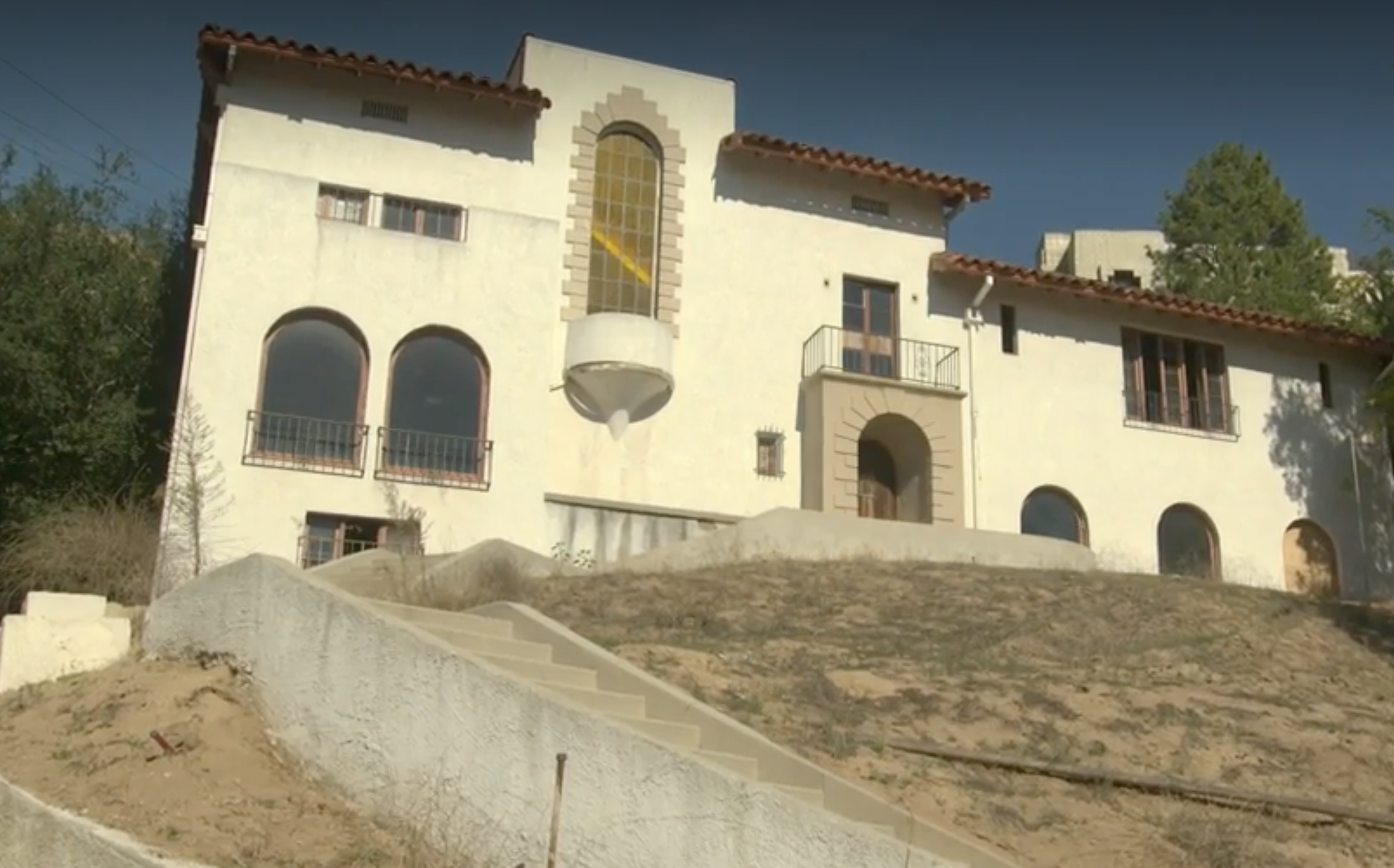
- calendar_month April 6, 2023
For being such a gorgeous, in-demand neighborhood, Los Feliz sure has its shadows. We examined the Sowden House, rumored to be the actual site of the notorious Black Dahlia murders. We explored the ancient curse allegedly levied against Griffith Park. But we’ve yet to discuss the Los Feliz murder house. We know what you’re thinking: “The Sowden House isn’t the Los Feliz murder house?!” No, there’s actually a home at the perimeter of Griffith Park even more steeped in urban legend. And thanks to some ace investigative journalism conducted in 2015 by writer Jeff Maysh, there’s now more truth to the legend than ever before. Since then, the house has even sold… a few times. And for a home that largely sat vacant for half a century, that’s big news.
The Haunting Look of the Los Feliz Murder House
There’s nothing unassuming about 2475 Glendower Place. For years, it’s looked like a haunted mansion. Perched atop a weedy hill punctuated by a mildew-stained stone stair walkway, its hollow arching windows are like stark black canvases awaiting painted nightmares.
Adopting the Spanish Revival style, designer Harry E. Weiner likely envisioned an exotic, palatial villa. Instead, it looks like it’s crumbling under the weight of its own ancient shadow. Or perhaps the shadow of something older and eldritch that predates its foundation.
But supernatural terrors aside, it’s a looming five-bedroom, four-bathroom mini-mansion dating back to 1925. It even boasted a ballroom and bar on its third floor, which would be charming under normal circumstances. But in light of the home’s history, it just provides a creepy setting pregnant with the potential for dread.
While the house was built for one Harry F. Schumacher, it exchanged ownership at least once before the 1950s when our story begins. It was around this time that Dr. Harold Perelson, an injection specialist, purchased the home. With his wife and three children, he painted a portrait of the American dream at work. Unfortunately, he’d be less remembered for the dream and more for the gruesome wake-up call.
“Lay Still”
At around 4:30 AM on December 6, 1959, the residents of Glendower Place awoke to the sounds of otherworldly shrieking. Soon, words formed: a garbled, female voice pleading “Don’t kill me”.
By this point, Dr. Perelson had already murdered his sleeping wife Lillian with one brutal bludgeoning of a ball-peen hammer to her head. That part was relatively quiet. The screaming didn’t start until he brought the hammer down on the head of his slumbering daughter, Judye.
However, in the shadows of 2475 Glendower Place, his precision was off. Judye was bleeding profusely, but still alive… and aware that someone was trying to kill her. In response to her pleas for mercy, her father simply replied “Lay still” and “Keep quiet.”
Shaking her crimson daze, Judye pushed past the murderous husk that once was her father in search of her mother. Upon finding her mother’s remains, Judye dashed shrieking into the once-tranquil night, down the hill and those cold stone steps, trailing blood to the neighbors’ houses, desperately searching for someone… anyone. By this point, concerned neighbors had already started dialing the police.
“This is a Nightmare”
Photo credit: Public Domain
Back in the family home that had transformed into the notorious Los Feliz murder house in mere seconds, Judye’s younger siblings were waking in a panic. Their father simply commanded them, “Go back to bed” before assuring them “This is a nightmare.”
One of the neighbors climbed the steps to try to confront Dr. Perelson. But he simply returned to his room and took two doses of Nembutal and over 30 tiny white pills, escaping where police couldn’t follow.
Paramedics arrived to find a bonafide house of horrors. The whites of Lillian’s eyes had been overtaken by red. Later the coroners would determine she’d drowned in her own blood. At some point, Dr. Perelson had placed a copy of Dante Alighieri’s The Divine Comedy on his nightstand. The pages were opened to Canto 1, with the depressingly grim opening passage:
“Midway upon the journey of our life
I found myself within a forest dark,
For the straightforward path had been lost.”
The Ripples of Calamity
Photo credit: Envato
There’s no point in searching for a method to this level of madness. But there were circumstances happening in the Perelsons’ lives that weren’t immediately obvious to their neighbors.
After being conned out of an investment in the production of a new syringe design he’d invented, Dr. Perelson had been facing deep financial calamity. And while the doctor’s family reported he’d been racked by coronary failures, these were later revealed to be failed suicide attempts.
Concerned, Lillian was allegedly planning to have him forcibly committed. Unfortunately, Dr. Perelson was said to have discovered the machinations moving behind his back. And he dealt with them in a way that only his mind could rationalize.
Limbo in the Los Feliz Murder Mansion
Less than a year after Dr. Perelson stained 2475 Glendower Place with his crimes, the home sold in a probate auction. Lincoln Heights husband and wife Julian and Emily Enriquez made the bold purchase. But from what little we know today, they never actually lived in the home.
And at this point, the facts and urban legends begin to seep into one another as is so often the case with allegedly haunted houses. For over the next half a century, the Los Feliz murder house existed in something of a twilight reality. It was there, as solid as ever. But with wildly differing accounts and little on official record, it’s hard to say what exactly happened in those decades… if anything.
The Ghosts of December
The Los Feliz murder house gained a reputation for presenting a tragedy suspended in time. Rumors spread about that murderous December night. A popular one rewrote history so that Dr. Perelson took his life by drinking a beaker of acid.
And, of course, there were the legends of grim ghosts populating the decaying mini-mansion. During the early years of the Enriquezes’ ownership, a family was said to have briefly rented the sprawling manor. But one evening, they saw something so horrible, that they fled, leaving all of their belongings, including wrapped Christmas gifts behind.
This was perpetuated by the fact that if you were bold enough to peer into the home’s windows, you’d find dusty furniture, a Christmas tree, and scattered, still-wrapped gifts. Internet sleuths somewhat confirmed this by taking photos through the windows.
There was no Christmas tree. But the wrapped gifts were there near decaying newspapers, an old boxy television, and an ancient can of Spaghetti-O’s. There were even framed photos of smiling faces on the walls.
Some hypothesized that these were the Perelsons’ belongings, forever caught in the state of that tragic night. But the Perelsons were said to be Jewish, lending credence to the theory that the gifts were hastily left by a fleeing family on the anniversary of the murder-suicide.
Then, there’s the unconfirmed rumor that numerous squatters fled the spacious premises, citing strange noises and pockets of freezing air.
Halfway Up the Weedy Hill
At this point, I’m going to do something I’ve never done on this blog and momentarily break the collective JohnHart “we” to discuss my own experience with the Los Feliz murder mansion. I visited the home on three separate occasions between the years 2012 and 2015.
Acquaintances of mine bragged about entering the premises to take souvenirs; vintage magazines, an army jacket, assorted paraphernalia. My intention was to simply peek in the windows to see the home frozen in time for myself.
I’m skeptical about the supernatural. But whether alone or with friends, I was never able to make it beyond the stone bench halfway up the weedy hill. I didn’t think I’d face some hideous apparition or anything like that. Rather, I just felt the heaviness of the scene of an intensely sad, yet grotesque tragedy.
Imagining Judye Perelson’s desperate run down that lawn in the wee hours of December 6, 1959 shook my nerves. Yeah, it was horrifying. But beyond that, it was the story of a young woman who had just been brutalized by her own father. And discovered the body of her mother, robbed from her through intensely barbaric means.
Photo credit: Alexis Vaughn
More than terror, I felt deep sorrow. And when I looked up the hill into those hopelessly black windows, I realized I’d seen as much as I wanted to see of 2475 Glendower Place.
In 1994, Emily Enriquez passed away, leaving the Los Feliz murder house to her son Rudy. He was largely private about the property, no doubt already feeling burdened by its notorious history. He wasn’t the only one.
Using a Murder House as a Storage Facility
Neighbors were frustrated by the constant stream of thrillseekers and true crime aficionados attracted to the decaying home. The security system was constantly going off in the middle of the night, no doubt triggered by the morbidly curious.
Perhaps in an attempt to demystify some of the legend, Enriquez did eventually open up about the notorious property. He clarified that he primarily used the sprawling manor for storage. The mythic Christmas gifts had been his; same with the assorted bric-a-brac. Much of the vintage furniture and other commodities were belongings left to him by deceased friends.
Like his parents, it seems Enriquez never moved into the Los Feliz murder house. While his brief interviews reveal a pragmatism that skirts the awed horror of the home’s typical spectators, the history was still maybe too much for him.
Photo credit: Alexis Vaughn
Yet, a phone line was officially registered at 2475 Glendower Place in 1987. And records uncovered by Los Feliz Murder Mansion Podcast host Stacy Astenius reveal that the home was receiving water and electric bills.
But these are all of the answers we’re likely to get. In 2015, Enriquez passed away. And suddenly, the home that had been locked in a shadowy purgatory was on the market again.
The Costly Future of 2475 Glendower Place
As we’ve discussed on this blog before, you only need to issue a death disclosure on a property if the death occurred within the last three years. So, while a realtor wouldn’t be obligated to detail the Los Feliz murder mansion’s horrid history, its reputation no doubt preceded it.
In 2016, controversial attorney Lisa Bloom, perhaps best known for representing disgraced movie mogul Harvey Weinstein, purchased 2475 Glendower Place for $2.29 million. The home needed extensive work to say the least. Yet, Bloom was still determined to remodel the rotting mini-mansion and move into it herself.
Photo credit: Court TV
Undeterred by decades old murders and ghost stories, Bloom was frightened off by something arguably more frightening. Contemporary building codes made the weedy hill upon which the home sat a pricey problem. In fact, the entire property would have to be demolished and the hill would need to be flattened.
This brought necessary preparations up to 50% of the home’s cost. Bloom had already stripped the home to its studs when she decided to throw it back to the market in 2019. Less than a year later, an LLC represented by Ephi Zlotnitsky, CEO of Luxmanor Custom Home Builders, purchased the husk of the Los Feliz murder house for $2.35 million.
Closing the Door on the Los Feliz Murder House
And with that, it seems the days of the Los Feliz murder mansion are numbered. We often champion the preservation of historically significant properties. But this home spent half a century soaking up its tragedy and little else. It showed in its edifice. On that awful night in December 1959, Dr. Perelson murdered this home too. Perhaps 2475 Glendower Place will at least get a second chance to grow out of the shadow of the legendary Los Feliz murder house.


